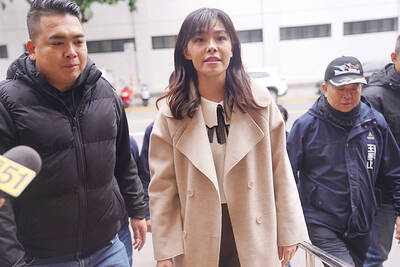US President Barack Obama said Washington is concerned China is using its “sheer size and muscle” to push around smaller nations in the South China Sea, drawing a swift rebuke from Beijing, which accused the US of being the bully.
China’s rapid reclamation around seven reefs in the Spratly archipelago (Nansha Islands, 南沙群島) in the South China Sea has alarmed other claimants, such as the Philippines and Vietnam, and drawn growing criticism from US government officials and the military.
While the new islands will not overturn US military superiority in the region, workers are building ports and fuel storage depots and possibly two airstrips that experts have said would allow Beijing to project power deep into the maritime heart of Southeast Asia.
“Where we get concerned with China is where it is not necessarily abiding by international norms and rules and is using its sheer size and muscle to force countries into subordinate positions,” Obama told a town-hall event in Jamaica on Thursday ahead of a Caribbean summit in Panama.
“We think this can be solved diplomatically, but just because the Philippines or Vietnam are not as large as China doesn’t mean that they can just be elbowed aside,” he said.
Chinese Ministry of Foreign Affairs spokeswoman Hua Chunying (華春瑩) said the US had no right to accuse anyone of pushing anyone else around.
“I think everyone can see very clearly who it is in the world who is using the greatest size and muscle,” she told a daily news briefing in Beijing yesterday.
The US needed to do more to show that it really wanted to play a constructive, responsible and positive role in the South China Sea, and should not ignore the efforts China and Southeast Asian nations have made to try and address the dispute, Hua added.
China claims most of the potentially energy-rich South China Sea, through which US$5 trillion in ship-borne trade passes every year. Taiwan, the Philippines, Vietnam, Malaysia and Brunei also have overlapping claims.
China, which has asked Washington not to take sides in the row, says it is willing to discuss the issue with individual countries directly involved in the dispute.
However, it has refused to participate in an international arbitration case filed by the Philippines in The Hague over the contested waterway.
US Secretary of Defense Ashton Carter, who is visiting Seoul, yesterday also gently chided China for its approach to territorial disputes in the South China Sea, suggesting Beijing has been isolated by its strong-arm tactics.
Speaking at a news conference with his South Korean counterpart, Carter implicitly accused the Chinese of militarizing the issue.
“One of the consequences” of not dealing with territorial disputes “in a multilateral, diplomatic fashion is it’s hard to have friends and allies that way,” Carter said. “And the United States has lots of friends and allies and partners in this part of the world.”
“We don’t conduct ourselves coercively, we don’t militarize situations like that,” he said.

The US government has signed defense cooperation agreements with Japan and the Philippines to boost the deterrence capabilities of countries in the first island chain, a report by the National Security Bureau (NSB) showed. The main countries on the first island chain include the two nations and Taiwan. The bureau is to present the report at a meeting of the legislature’s Foreign Affairs and National Defense Committee tomorrow. The US military has deployed Typhon missile systems to Japan’s Yamaguchi Prefecture and Zambales province in the Philippines during their joint military exercises. It has also installed NMESIS anti-ship systems in Japan’s Okinawa

‘WIN-WIN’: The Philippines, and central and eastern European countries are important potential drone cooperation partners, Minister of Foreign Affairs Lin Chia-lung said Minister of Foreign Affairs Lin Chia-lung (林佳龍) in an interview published yesterday confirmed that there are joint ventures between Taiwan and Poland in the drone industry. Lin made the remark in an exclusive interview with the Chinese-language Liberty Times (the Taipei Times’ sister paper). The government-backed Taiwan Excellence Drone International Business Opportunities Alliance and the Polish Chamber of Unmanned Systems on Wednesday last week signed a memorandum of understanding in Poland to develop a “non-China” supply chain for drones and work together on key technologies. Asked if Taiwan prioritized Poland among central and eastern European countries in drone collaboration, Lin

BACK TO WORK? Prosecutors said they are considering filing an appeal, while the Hsinchu City Government said it has applied for Ann Kao’s reinstatement as mayor The High Court yesterday found suspended Hsinchu mayor Ann Kao (高虹安) not guilty of embezzling assistant fees, reducing her sentence to six months in prison commutable to a fine from seven years and four months. The verdict acquitted Kao of the corruption charge, but found her guilty of causing a public official to commit document forgery. The High Prosecutors’ Office said it is reviewing the ruling and considering whether to file an appeal. The Taipei District Court in July last year sentenced Kao to seven years and four months in prison, along with a four-year deprivation of civil rights, for contravening the Anti-Corruption

NO CONFIDENCE MOTION? The premier said that being toppled by the legislature for defending the Constitution would be a democratic badge of honor for him Premier Cho Jung-tai (卓榮泰) yesterday announced that the Cabinet would not countersign the amendments to the local revenue-sharing law passed by the Legislative Yuan last month. Cho said the decision not to countersign the amendments to the Act Governing the Allocation of Government Revenues and Expenditures (財政收支劃分法) was made in accordance with the Constitution. “The decision aims to safeguard our Constitution,” he said. The Constitution stipulates the president shall, in accordance with law, promulgate laws and issue mandates with the countersignature of the head of the Executive Yuan, or with the countersignatures of both the head of the Executive Yuan and ministers or